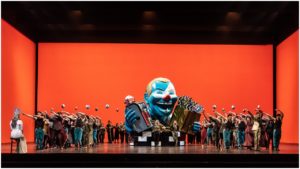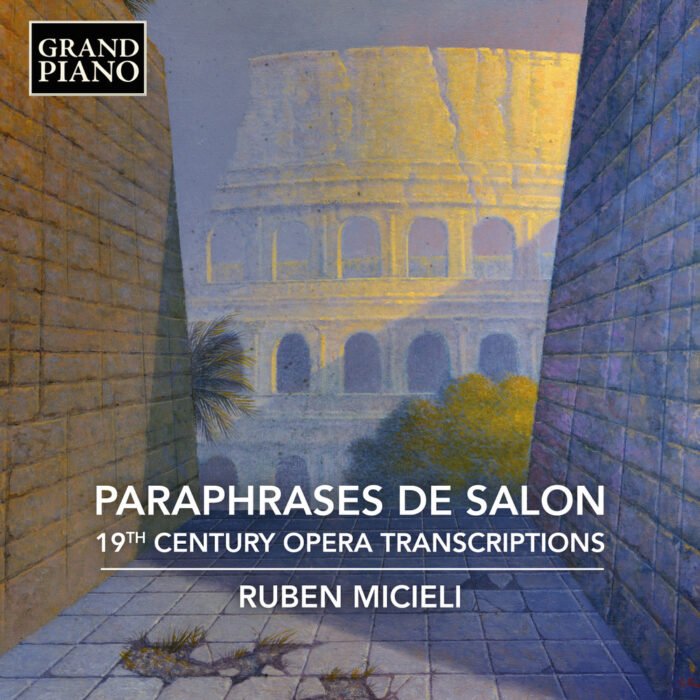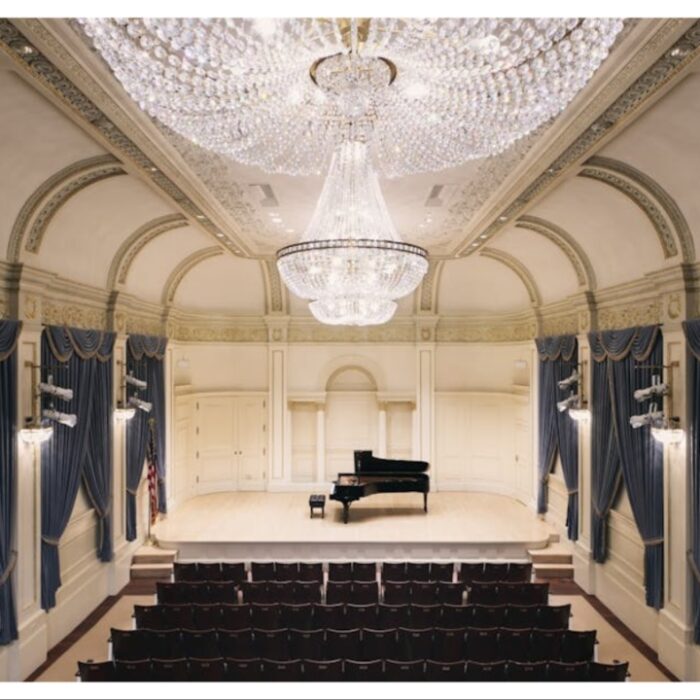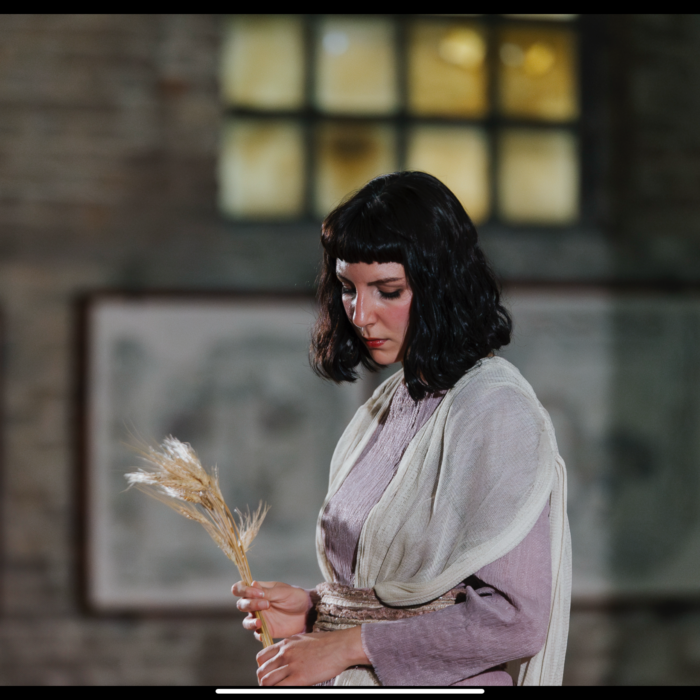
Royal Opera House 2021-22 Review: Samson et Dalila
Richard Jones’ Production Fails to Catch Fire Despite Peerless Principals
By Benjamin Poore(© 2022 ROH. Photograph by Clive Barda)
Camille Saint–Saëns’ “Samson et Dalila” received its first new production – indeed first performance – at the Royal Opera House in nearly 20 years, replacing Elijah Moshinsky’s, which had a vintage of 1981 (before this reviewer was even born). It’s a tricky work to get right – traditionalist stagings feel uncomfortably Orientalist, sometimes just plain naff in a Cecil B DeMille way – and cooler, more contemporary visions can leave the audience feeling rather chilly. It’s a thematically evocative work – f populist uprising, religious demagoguery, societies sliding into decadence – all map richly onto Saint–Saëns; own late 19th-century context, and indeed should speak with clarion force today.
Richard Jones’ new effort offers a wildly uneven take on a somewhat uneven piece – like Berlioz’s “The Damnation of Faust” it is an odd blend of cantata, oratorio, and grand opera, further complicated by Saint–Saëns’ ambivalence about post-Wagnerian sensuality. Antonio Pappano returns to the pit alongside a stellar cast – veteran Dalila Elīna Garanča takes the title role – and musical values tend to exceed dramatic ones.
An Uneven Production
There are powerful nods to 20th-century cinema in Hyemi Shin’s designs. Busby Berkley looms in the dance sequences – especially at the end – and Dalilah’s headdress in the final scene suggests Fritz Lang’s mechanical nightmare “Metropolis”. These gestures are the most promising and evocative in the show. The setting is broadly contemporary, with the characteristic wide open staging that Jones favors, albeit contained at times in a large raked central box that houses the opening scene.
The Bacchanale felt oddly anti-climactic. The expensive centerpiece is the clown-mascot of Dagon, a pile of casino chips and coins, which squats hideously – effective enough – but is revolved to little purpose by stagehands. The ROH chorus makes an admirable fist of the line-dancing and quasi-West End choreography given to them – reluctance seemed to be written unmistakably on their faces – but the visual spectacle is rather muted in the cavernous stage space, and doesn’t match Pappano’s attempts to whip the orchestra into a frenzy. The spectacle is, as is Jones’ mood, ironic – Samson’s strength is shown early in Act one when he grasps an enormous rope to pull onstage the raked box in which the Jews gather for their opening scene. It is both schlocky and bathetic.
There are some smart touches in Jones’ often acute personregie. Dalila is rendered more sympathetic – her decision to turn on Samson comes from seeing the body of her murdered kinsman, and in the final scene, she looks on the public torture of the hero with increasing horror, though this emotional journey feels oddly incidental. Other moments feel flat – soldiers bully the Jews in the opening dumb show by throwing a woman’s shopping on the floor; one menaces everyone else by ostentatiously eating an apple. It is cartoonish rather than oppressive; the same can be said for the movement given to the High Priest’s goons in Act two.
Act two’s designs are rather a mystery – an unvarnished wooden shack that feels rather more Norse than Gazan, though it does have a spinning fan. This scene is lit by Andreas Fuchs in an unappealing shade of yellow for most of what is meant to be a breathy and sensuous seduction sequence. Jones has previously made use of stark – indeed garish – stage pictures to open up ironies in a libretto, but here the mood is oddly queasy rather than probing or, well, sexy. The blocking lacked definition, with the pair of them wandering about on a cavernous stage, and Dalila’s fiddling with Samson’s hair in “Mon cœur s’ouvre à ta voix” felt fussy and awkward.
The final few minutes are an orgy of tacky – here Jones hits the right note, making a rancid spectacle of the Philistines’ decadent world. It’s a Hollywood epic in full technicolor that has gone sour, with the grotesquerie of an all-singing and all-dancing musical. We don’t get much of a collapsing ceiling, sadly, but it’s a huge improvement on Act two. Another relative success is the opening scene of Act three, with Samson in his cell – which is rather like a stairwell – but is well-lit; a box suspended in darkness while the chorus cries out from the wings.
Revelatory Performances
Musically, the show fires on every cylinder. Elīna Garanča executes the role perfectly. The darkest, lowest notes were the money-makers. In this role she marshalls her instrument with nuance – the sound is buttery, even smoky, and then sharpened into a razor edge for moments of fury, frustration, and defiance.
SeokJong Baek replaced Nicky Spence in the show, and may well be the outstanding voice of the cast. He navigates the challenging vowels of French singing – in most hands, they veer between reedy and nasal – with remarkable sensitivity and strength. Most importantly, he was untiring. There were baritonal shades as his suffering increased across the show, not least in his solo scene in his cell. At the climax of the work, there was a heroism in the sound – a darker brashness – that had moved a long way from the lyric naivete of Act one. Let’s hear him sing Don Jose.
Łukasz Goliński’s High Priest is a captivating vocal presence, with malicious darkness across his range, and cruelly ringing top notes. Blaise Malaba sang a stentorian Abimélech; his counterpart in Goderdzi Janelidze as the Old Hebrew sang some floor-shaking low notes and made an ominous foil to Samson, whom he tutors and chides.
Antonio Pappano demonstrates an uncanny ear for unexpected moments of textural interest, sudden dynamic contrasts, or exquisitely underlined cadences; his orchestral palette feels, as ever, highly connected to the text, either highlighting or ironizing it with grace and insight. The ROH orchestra did not put a foot wrong and blazed through the score with the fervor of a zealot. The chorus singing itself is fabulous, especially thrilling in the final sequences, where the complex choral writing gleamed; their offstage interjections too, at the top of Act three and at the very opening of the opera rippled with portent and doom.


